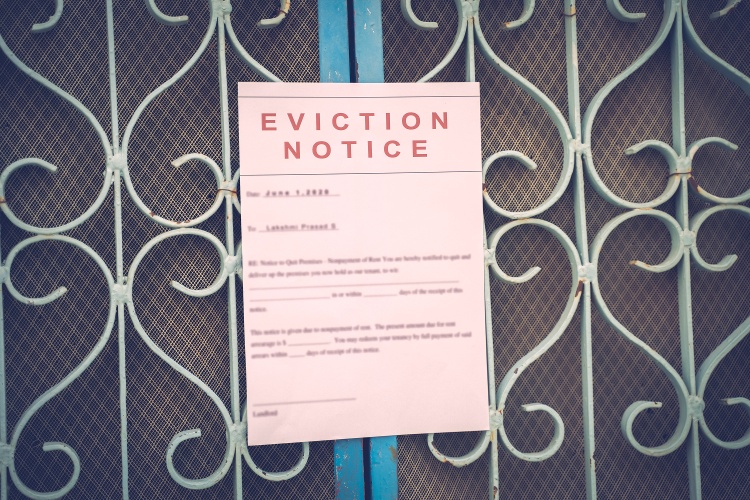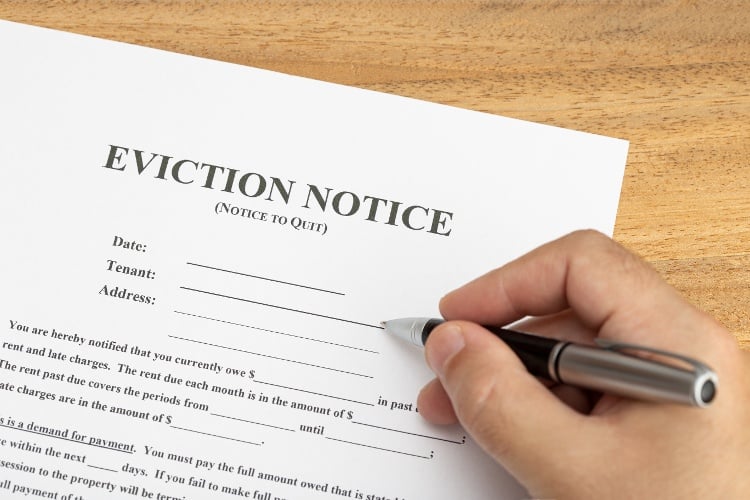Even the most experienced rental property owners are faced with having to evict a tenant from time to time.
Although having to evict a tenant is never fun, evictions are part of the rental property business. If a tenant can’t pay rent, refuses to pay, or starts to destroy your property, you may need to evict the tenant to protect your property.
In this article, we'll explain how to evict a tenant, two possible ways to get rid of a tenant without having to evict and offer some tips on how to avoid renting to a tenant you may end up having to evict.
What is an eviction?
Eviction is the process landlords used to recover the possession of leased real property from tenants who do not want to leave. As the Legal Information Institute (LII) at Cornell Law School notes, evictions are difficult, painful, and expensive for all parties involved.
The most common reason for evicting a tenant is nonpayment of rent. Sometimes tenants want to pay the rent, but they are financially unable to do so. Other times landlords may make the mistake of leasing to a “professional tenant” who simply refuses to pay the rent, living in the property rent-free until they are evicted.
Other common reasons for eviction include violating one or more terms and conditions of the rental agreement, such as dealing drugs, destroying the rental property, or having unauthorized roommates or pets.
Main types of eviction notices
Evictions are “for cause”, which means that the tenant has done something that forces the landlord to send a notice that begins the eviction process.
Sometimes the tenant can “cure” the violation, such as catching up on the rent and any late fees or getting rid of the unauthorized roommate. An eviction can also be incurable or unconditional, such as conducting illegal activity on the property or repeatedly not paying the rent on time:
- Pay or quit notice is used when the tenant owes rent and contains a short period – normally of between 3 – 5 days – to cure the violation by paying the rent or moving out.
- Cure or quit notice is used when the tenant violates another term or condition of the rental agreement, such as having a pet or being a nuisance to the neighbors.
- Unconditional quit notice is used to force the tenant to leave immediately without the chance of correcting the violation, such as consistently violating one or more lease terms, seriously damaging the property, or dealing drugs, or engaging in acts of prostitution.

Where to find state eviction laws
The how, what, when, where, and why of evicting a tenant varies from state to state. Each state – and sometimes individual cities – have landlord-tenant laws that describe the process a landlord must follow to legally evict a tenant.
Online resources
Nolo.com is a legal resource website for rental property owners and real estate investors. The site includes:
- State landlord-tenant laws
- State laws on termination for nonpayment of rent
- State laws on unconditional quit terminations
Local real estate attorney
A recent post on the BiggerPockets website suggests that in most cases a landlord should hire a lawyer to evict a tenant (while some states require it). Reasons for using an attorney to evict a tenant include:
- Eviction can be a complex process.
- Most landlords don’t have the required level of knowledge and expertise.
- Some landlords may become emotionally involved when evicting a tenant.
- Peculiarities of state and local landlord-tenant laws.
Good resources to find a local real estate attorney in your market are LawInfo.com, Avvo.com, and LegalMatch.com. Many areas also have real estate attorneys who specialize in residential evictions for a flat fixed fee, rather than an expensive hourly rate.

How to evict a tenant: 8 important steps
Rental websites such as Cozy and Zillow Rental Manager provide real estate investors with good, free tenant screening tools. Unfortunately, landlords who thoroughly screen tenants may end up with a bad one every now and then.
When – and if – a rental property owner needs to evict a tenant, there are 8 important steps:
Step #1: Know your local laws
Review your state and local landlord-tenant laws to understand the process a landlord must follow when evicting a tenant. In some cases, landlords who don’t follow the letter of the law may actually be held liable and ordered to pay the tenant damages, even though it was the tenant who was originally in the wrong.
Step #2: Make sure the reason for evicting is valid
Reasons for a valid eviction vary from state to state. Generally speaking, valid reasons for evicting a tenant include nonpayment of rent, violation of one or more terms of the lease, destroying the property, conducting illegal activity, or refusing to leave when the lease expires.
Step #3: Speak with the tenants
Before you begin the time-consuming and expensive process of evicting the tenant, speak with them to see if there’s a win-win way to resolve the situation without having to go to court.
In today’s age of instant messaging and social media, sometimes meeting face-to-face with the tenant can yield surprisingly positive results. When you do meet, try to arrange the meeting in neutral territory such as a coffee shop instead of at the rental property.
Step #4: Deliver a written eviction notice
If all else fails, the next step is to deliver a formal eviction notice to the tenant. State law dictates how delivery should be done, but usually requires personally serving the written notice and certified delivery with proof of receipt.
A written eviction notice should include the date the tenant must cure or quit, the total amount owed by the tenant in the case of unpaid rent, and the number of days the tenant has to respond or leave before beginning the eviction process with the court.
Step #5: File the eviction in court
The clerk at your local courthouse will ask you to pay a filing fee and then schedule a hearing date for the eviction.
In most cases, you’ll be asked for a copy of the notice given, proof of delivery, and evidence that the tenant was provided with the allowed amount of time to respond. Once the clerk is satisfied that you have followed the proper eviction procedures, the court will send a process server to notify the tenant that a lawsuit is pending.
Step #6: Prepare documents and attend the court hearing
Documents you should prepare and bring to court for the judge to review include the original executed lease agreement, payment records such as a rent roll and bank statements, copies and notes of correspondence between you and the tenant, a copy of the written eviction notice, and proof of delivery.
Step #7: Evict the tenant
In many cases, a tenant being evicted will not show up for the court hearing, and the odds are the judge will rule in your favor. If the tenant does appear, the judge will listen to both sides, and most likely rule in your favor provided you’ve done everything right.
The tenant will be ordered to vacate the property, and you may need to arrange with local law enforcement such as the sheriff’s department to remove the tenant from the property if they refuse to leave.
Step #8: Obtain a judgment and collect past due rent
Depending on the local court system, you may be awarded a judgment for any past due rent and damages caused by the tenant. Other times, you may need to file a separate lawsuit in small claims court.
Either way, you will need to hire a collections agency or attorney to collect on your judgment. The collections agency will report the judgment to the credit bureaus, skiptrace the tenant if they have disappeared, garnish wages of the tenant if they are employed, and file a claim on any other assets owned by the tenant.
How to evict a tenant quickly
At this point, you may be wondering if there’s a way to legally speed up evicting a tenant, without cutting corners. The answer is that there is. In fact, there are two good ways to try and evict a tenant quickly without having to evict:
1. Offer the tenant cash for keysAlthough it may seem counterintuitive to pay the tenant to leave when they owe you money, cash for keys can make good financial sense.
According to TransUnion SmartMove, the cost of an eviction averages $3,500 and can take between 3-4 weeks from start to finish, while a post on BiggerPockets estimates the cost to evict is twice as much.
The bottom line is that the sooner the tenant leaves, the quicker you can cut your losses and get the property ready to rent to a better, more qualified tenant.
2. Talk the tenant into leavingMeeting with the tenant face-to-face and asking them to leave is another good way to evict a tenant quickly without spending money on a formal eviction. Once tenants understand the ramifications of being evicted – such as a bad credit report, garnished wages, and a bad rental history report – they may be more than willing to leave.
When you do reach an agreement with the tenant, be sure to put everything in writing with both you and the tenant signing the agreement. That way, if the tenant still refuses to leave, you’ll be able to prove to the judge that you did everything you could to avoid having to evict the tenant.
Can you evict a tenant without a lease?
One of the advantages of having a “tenant-at-will” on a month-to-month lease agreement is that you usually don’t have to give the tenant a reason for terminating the lease. In most states, all that is required is a 30-day notice by either party to terminate a month-to-month lease.
Nolo.com maintains an updated report on the state rules on the notice required to change or terminate a month-to-month tenancy.
How to avoid an eviction
Avoiding having to evict a tenant begins with good tenant screening. There are a number of good online tenant screening services that landlords can use for free by having the tenant pay for the screening fee.
- Good tenant screening services will include reports on the tenant such as:
- Credit report and score
- Previous address rental history
- Multi-state criminal and sex offender reports
- Terrorist check
- Eviction history
- SSN and identity verification
Wrapping up
In the rental property business, you can do everything right, but sometimes things don’t always go according to plan. While some real estate investors own property for years without going through a single eviction, other owners aren’t so lucky.
Although having to evict a tenant can be time-consuming and expensive, you may be able to talk them into leaving by offering cash for keys. No matter what you do, don’t break any landlord-tenant laws (like changing the locks, removing their belongings, or cutting off the utilities).
Learn from your mistakes, and focus on getting a better tenant next time who will help keep your cash flow strong and your rental property increasing in long-term value.









